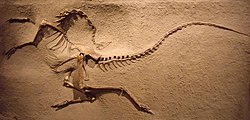Arthropods
Insects
| Name | Novelty | Status | Authors | Age | Type locality | Location | Notes | Images |
|---|---|---|---|---|---|---|---|---|
sp. nov | jr synonym | A moth, moved to Paleolepidopterites destructus (2018) [3] |  | |||||
| |||
|---|---|---|---|
| +... | |||
Paleontology or palaeontology is the study of prehistoric life forms on Earth through the examination of plant and animal fossils . [1] This includes the study of body fossils, tracks ( ichnites ), burrows , cast-off parts, fossilised feces ( coprolites ), palynomorphs and chemical residues . Because humans have encountered fossils for millennia, paleontology has a long history both before and after becoming formalized as a science . This article records significant discoveries and events related to paleontology that occurred or were published in the year 1917.
| Name | Novelty | Status | Authors | Age | Type locality | Location | Notes | Images |
|---|---|---|---|---|---|---|---|---|
sp. nov | jr synonym | A moth, moved to Paleolepidopterites destructus (2018) [3] |  | |||||
| Name | Novelty | Status | Authors | Age | Type locality | Location | Notes | Images |
|---|---|---|---|---|---|---|---|---|
Valid | Haughton | 250 Millions years ago |  | |||||
Valid | Van Hoepen | 250 Millions years ago | ||||||
Valid | Haughton | |||||||
| Name | Novelty | Status | Authors | Age | Type locality | Location | Notes | Images |
|---|---|---|---|---|---|---|---|---|
Gen et comb nov | Petronievics | Moved from Archaeopteryx siemensii (1897) |  | |||||
| Taxon | Novelty | Status | Author(s) | Age | Unit | Location | Notes | Images |
|---|---|---|---|---|---|---|---|---|
| Cheneosaurus [5] | Gen. et sp. nov. | Jr. synonym | Lambe | Campanian | Horseshoe Canyon Formation | Juvenile of Hypacrosaurus | ||
| Edmontosaurus [6] | Gen. et sp. nov. | Valid | Lambe | Campanian | Horseshoe Canyon Formation | A hadrosaurid |  | |
| Struthiomimus [7] | Subgen. nov. | Valid | Osborn | Campanian | Oldman Formation | A new subgenus for Ornithomimus altus elevated in 1972 |  | |